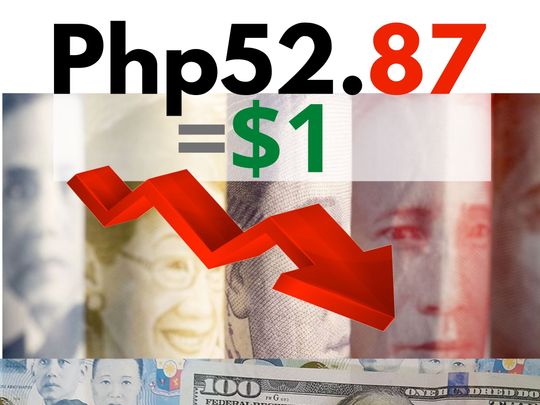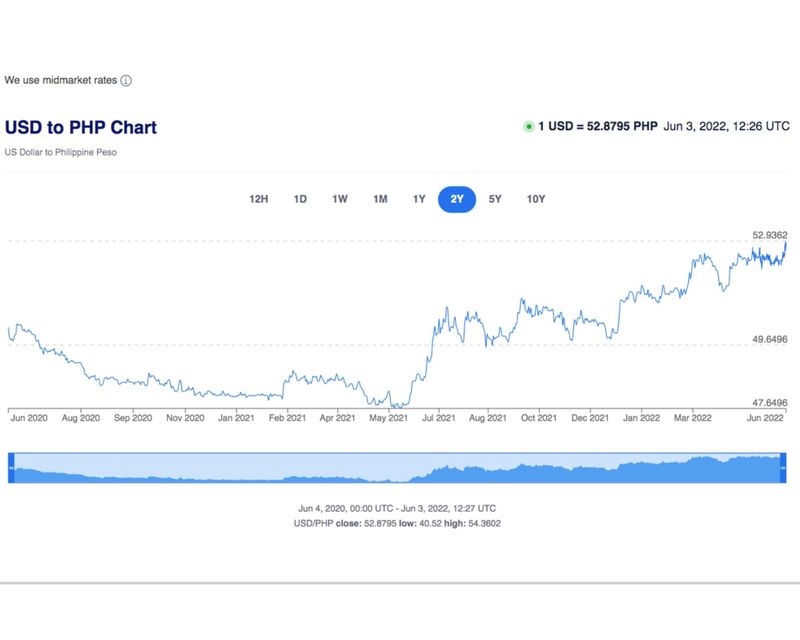
Highlights
- More jobs created in manufacturing, stocks end higher
- Higher T-bill yields prop up demand for the US dollar
- Central bank chief ‘not concerned’ about peso’s decline
Manila: Overseas Filipino workes (OFWs) continues to enjoy a virtual pay raise, as the Philippine currency tumbled further down to Php52.8795 against the dollar on Friday (June 3), after already hitting a three-year low on Thursday (June 2).
The slide came as the local economy showed signs of continued strength alongside higher Philippine Treasury yields, thus boosting the US currency.
For the latest currency and gold rates, click here.
Friday's peso-dollar rate was recorded by both Western Union and xe.com. The slide came a day after the Philippine money weakened to a three-year low, having breaking a key level of support of around 52.50 vs $1, which it had held since the middle of March 2019.

Policymakers have been warned of accelerating global inflation and amid signs of economic expansion, following 2 years of lockdowns.
T-bills
Treasury bill yields in April went up to 1.248% for 91-day Treasury bills, from 1.002 in the first quarter of 2022, while 364-day T-bills jumped to 1.88% in April from 1.514% in Q1, according to central bank data.
Based on the Bureau of Treasury’s (BTr) latest monthly report, the national government’s borrowings increased at the end of April by 0.7% — by Php83.4 billion — to Php12.76 trillion ($241.21 billion), from Php12.68 trillion at end-March.
About 70%, or Php8.94 trillion, of the total debt was borrowed from domestic lenders, through the issuance of government T-bills.
‘Not concerned’
On Thursday, the Philippine money tumbled as much as 0.5% to 52.76, the weakest in three years. This paves the way for further declines, say analysts.
Philippine central bank governor Benjamin Diokno recently said he’s “not concerned” about the recent peso weakness, as the Asian currency is widely expected to allow for some catchup with regional currencies.
According to the Friday reference exchange rate data from the Bangko Sentral ng Pilipinas (BSP), however, the peso closed at 52.58 to the greenback, from Php52.46 on Thursday.
The peso averaged Php51.976 in April and 52.46 in May, BSP data show.
Stocks up
Meanwhile, the Philippine stock market closed 54.57 points higher or 0.82% on Friday as the US shares index recovered on heavy trading activity.
The all-shares board went 20.73 points higher, at 0.58%. Mining and Oil sectors led the gainers across the board, at 277.55 points, or 2.28%, followed by the Property sector. Industrial, Services, Holding Firms and Financials made slight gains for the day.
The Philippines manufacturing sector has expanded for four straight months while factories recorded an increase in their workforce for the first time since February 2020, latest survey data show.
Philippine factories have reported growth for four straight months, showing improvements in the country's manufacturing sector. On Wednesday, the S&P Global Philippines Manufacturing Purchasing Managers’ Index (PMI) showed that that the domestic sector posted a score of 54.1 last month.
A score of 50 or higher indicates growth in the sector, while below the neutral score reflects a downward trend.








